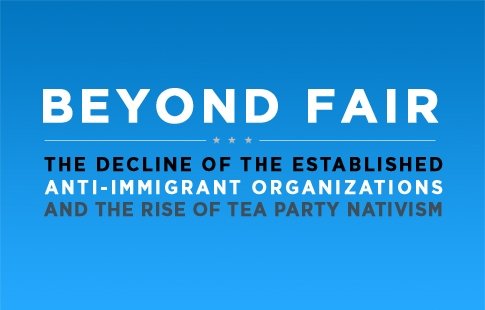Trend Two: The Nativist Establishment and the Tea Party
The inter-locking of the Tea Party and anti-immigrant movements is a multi-sided phenomenon. Tea Parties have included anti-immigrant sentiment, action and activists from the start, as IREHR has documented. In this report, IREHR documents the extent to which organizations and individual leaders that comprise the Nativist Establishment have reached out and found a place inside the Tea Parties.
In the course of IREHR’s ongoing work monitoring anti-immigrant activity, IREHR has identified just over six hundred different leaders in the Nativist Establishment—those who have played a significant recent role in a national institution, think tank, political action committee, or grassroots group. In this report, IREHR catalogues 107 different leaders in the Nativist Establishment who have been involved in the Tea Party at some level. This activity includes a range of participation levels: from attending Tea Party rallies, to speaking at Tea Party events, to joining one (or more) national Tea Party faction, to taking up a leadership role in a local Tea Party group.
Figure 6: Location of Nativist Establishment Leaders Active in the Tea Party
The 107 Nativist Establishment leaders IREHR has identified come from 97 different anti-immigrant groups including: seven national nativist institutions, 36 Minuteman chapters, 23 FIRE Coalition groups, and 32 other local nativist groups. Among these Nativist Establishment leaders, 46 are members of one or more of the national Tea Party factions.
This didn’t happen overnight. And not all sectors of the Nativist Establishment reacted the same way.
Grassroots nativist groups experienced the rise of the Tea Party first-hand and responded quickly. Consider in this regard the Federal Immigration Reform and Enforcement (FIRE) Coalition. As noted earlier in this report, FIRE Coalition activity had declined sharply during 2008, and the remaining constituent groups and individuals were looking for a way to rekindle their spark. FIRE Coalition leaders quickly identified and sought to capture some the energy of the opposition to then President-elect Obama after the 2008 election.
In December 2008, FIRE Coalition leaders launched a second enterprise, The Patriot Coalition. Of the nine chapters of this new Patriot Coalition, all but one was established by people previously connected with the FIRE Coalition. While the FIRE Coalition still targeted immigrants, the Patriot Coalition expanded its range of issues, including the battle against “globalism,” “socialism” and the “loss of National Identity and Culture.”
This Patriot group never really grew, but it did become a stepping stone into Tea Party activism.[46]
FIRE Coalition groups began promoting and participating in Tax Day Tea Party events as early as April 2009. And many FIRE Coalition leaders stayed with the Tea Parties. Of the ninety four different FIRE Coalition team leaders, at least twenty three became active with Tea Party groups, either at the local or national level.
For example, Bob Bowser, once the Kansas state director for the FIRE Coalition became the state director for the Patriot Action Network (the Tea Party formerly known as ResistNet). Dennis Drake, the FIRE Coalition’s Southern Indiana team leader, became a Patriot Action Network coordinator, in addition to becoming a member of the Tea Party Patriots and the local Tri-State Tea Party. In Mississippi, the director of the statewide FIRE Coalition group, MFIRE became a director in the Central Mississippi Tea Party Inc., as well as becoming a member of the Tea Party Patriots and the Patriot Action Network.
A close ally of the FIRE Coalition groups, William Gheen and his group Americans for Legal Immigration PAC (ALIPAC) followed the FIRE Coalition into the Tea Party. In April 20009, ALIPAC pulled together a coalition of nativist groups to show up at Tax Day Tea Party rallies.[47] The anti-immigrant groups set up booths at these events, handed out fliers and waved signs with slogans like, “No Taxation For Illegal Immigration”, “Illegal Aliens Steal Our Tax Resources!”, “Secure Our Border Secure Our Taxes!”, “No Tax Benefits For Illegal Aliens!”, and “Amnesty Equals Higher Taxes!”[48] In the fall of 2009, ALIPAC piggybacked onto Tea Party Rallies across the country, holding “Tea Party Against Amnesty” events in over 40 cities.[49]
In 2011, Gheen shifted the ALIPAC rhetorical attacks to appeal more directly to the Tea Party crowd. Instead of just immigrant bashing, Gheen set his sights on president Obama, who he argued has become a dictator who plans use undocumented immigrants to wage war on “White America.” He went so far as to proclaim that, “extra-political activities that I can’t really talk about because they’re all illegal and violent” may be needed to take down the president.[50]
Minutemen groups also used the Tea Party to re-invent themselves.
After Al Garza resigned from his post as Minuteman Civil Defense Corps vice-president in August 2009, he created a new group, also called The Patriots Coalition.[51] (Though they shared the same name, Garza’s group was separate from The Patriot Coalition formed by FIRE Coalition leaders.) And Garza’s Patriot Coalition quickly became enmeshed in the Tea Party scene.
Around this same period, Minuteman Project executive director Steve Eichler and media director Tim Bueler worked their way into the leadership of the 1776 Tea Party, the smallest of the national factions, as noted in IREHR’s report, Tea Party Nationalism. Eichler and Bueler formally became corporate directors of the 1776 Tea Party on October 28, 2009, according to records filed with the Texas Secretary of State. Much of the day-to-day operations and the public relations of the 1776 Tea Party shifted to Eichler, who became the 1776 Tea Party executive director in addition to his corporate board role, and to Bueler, who became media director while also keeping his corporate board role. To top it all off, their Minuteman Project boss, Jim Gilchrist, officially joined the 1776 Tea Party on December 12, 2010.[52]
Chris Simcox ceased Minuteman Civil Defense Corps operations in 2010, around the time he started to campaign for the Senate. He became a feature on the Tea Party rally circuit during the year, speaking to numerous Tea Party crowds in Arizona. He lost in the GOP primary.
The MCDC headquarters may have closed, but Simcox didn’t shut down the lucrative related political action committees. In 2011 the Simcox-affiliated Minuteman PAC rebranded itself to appeal to the Tea Party movement. To become more Tea Party-like, the PAC emailed out racist birther fundraising appeals and added an Islamophobic “Third Jihad Watch” section to their website.[53]
Overall, thirty six leaders of various Minuteman groups have been active with the Tea Party. That figure includes the national figures like Gilchrist, Simcox, Eichler, Bueler, and Garza. It also includes local leaders like Lex Price, the former director of the Emporia, Kansas chapter of the Minuteman Civil Defense Corps. Price became a leader in the Emporia Tea Party and Kansans for Constitutional Integrity.
In addition, several of the remaining local Minuteman chapters have worked in partnership with local Tea Party groups. Differentiating where the Minutemen stop and the Tea Party begins has become increasingly difficult.
Even Glenn Spencer, with a border vigilante vintage that pre-dates the Minutemen, has tried to use the Tea Party to resurrect his career. Spencer had run an anti-immigrant outfit called American Border Patrol, but his visibility had greatly diminished in recent years, particularly after his record of racism and anti-Semitism became well known.[54] The Tea Party movement has given Spencer a new staging area, however, including an opportunity to promote his racist “reconquista” conspiracy theory. Spencer is a “rising star in the Tea Party movement” who travels “almost weekly” to speak at Tea Party events, according to Media Matters for America. Tours of Spencer’s ranch, including a briefing from Spencer, are being sponsored by the Arizona 2012 Project, an affiliate of the Tea Party Patriots. Spencer’s ranch was also used to host a 2010 Tea Party Nation anti-immigrant rally that drew nearly six hundred people.[55]
In addition to the previously mentioned leaders, thirty other grassroots leaders from the Nativist Establishment have been active in the Tea Party. Some have taken leadership positions in local Tea Party groups. Some have joined national Tea Party factions. And others have changed the name of their local nativist group to try and fit in with the Tea Party movement.
A complete list of the leaders that IREHR has uncovered is available in Appendix A.






